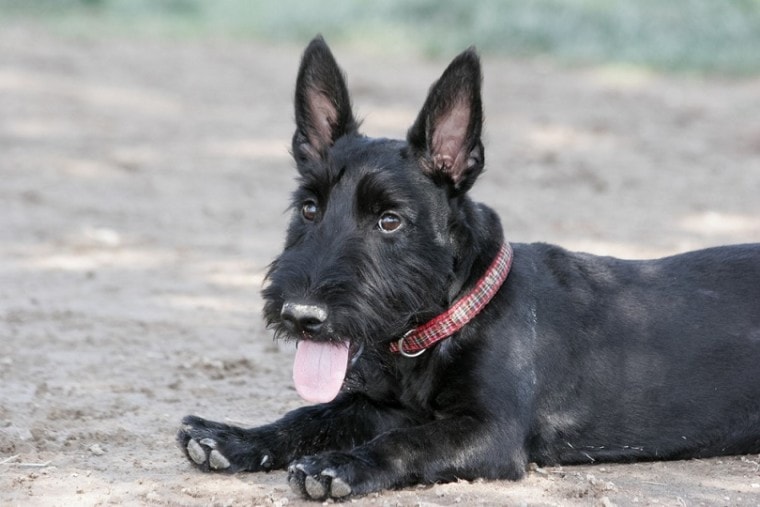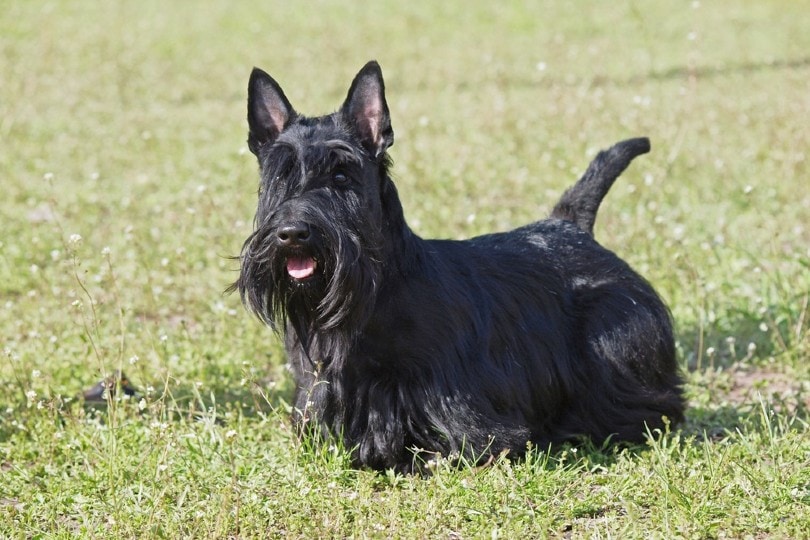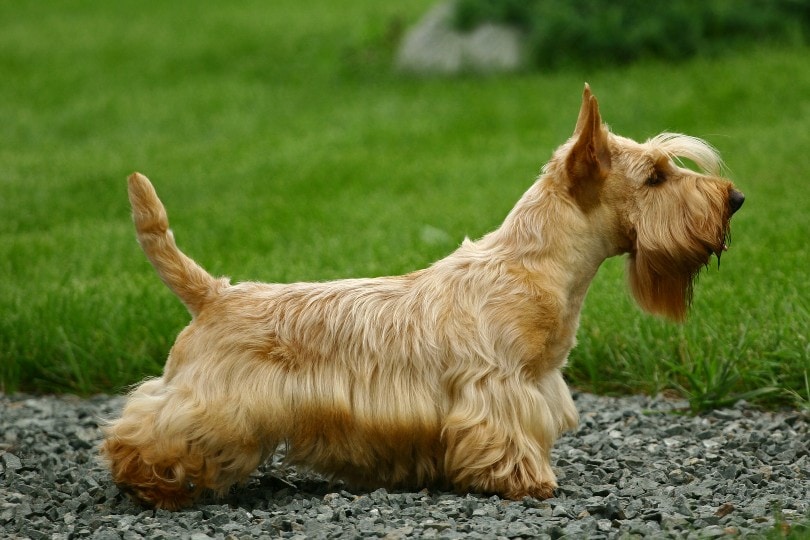
Click Below to Skip Ahead
Scottish Terriers have a charming appearance that has captivated many celebrities and royal family members all throughout history. They may appear to be aloof at first glance, but once you get to know them, you’ll find out that their personalities are just as charming as their looks.
Breed Overview
Height:
10 – 11 inches
Weight:
18 – 22 pounds
Lifespan:
12 – 15 years
Colors:
Black, wheaten, brindle
Suitable for:
Experienced dog owners, apartment dwellers, families with children
Temperament:
Alert, independent, intelligent, playful, watchdog
These fun and loyal dogs do take some time to warm up to you and trust you, so it’s important to make sure that you do your research before bringing home a Scottish Terrier puppy. This guide will help you better understand this dog breed and its specific care needs so that you can make sure that you’re a good fit for each other before embarking on a journey together.
Scottish Terrier Characteristics
 Scottish Terrier Puppies
Scottish Terrier Puppies

There are plenty of healthy Scottish Terrier puppies from reputable breeders or dog shelters. Just make sure to do your research when looking for Scottish Terrier puppies. Reputable breeders will generally have memberships in different dog clubs and organizations, such as the American Kennel Club (AKC) and the Scottish Terrier Club of America (STCA). They’ll also be highly knowledgeable about the breed and breeding practices and they will show much love and care for their Scottish Terrier puppies. Check to ensure that the puppies have received the age-appropriate vaccinations and deworming and request a copy of their health records.
When you welcome a Scottish Terrier into your home, be ready for a lovable and affectionate pup to become a part of your family. Keep in mind that they’re independent dogs that might be challenging to train.
Temperament & Intelligence of the Scottish Terrier
Some hallmark characteristics of the Scottish Terrier are its intelligence, loyalty, and feistiness. However, these traits aren’t quickly revealed to strangers. Scottish Terriers tend to be aloof and independent, so they do best with experienced dog owners who can provide consistent training that respects their independence.

Are These Dogs Good for Families? 👪
Companionship is in this breed’s DNA. Once they bond with an owner and family, they’re extremely loyal and watchful for any potential threats or danger. Although they’re aloof towards strangers, these dogs love to be active participants in their homes.
They should always live inside the house, and they’ll do well in families where at least one person is home for most of the day. This dog breed will get stressed out if it’s left home alone for long hours.
Scottish Terriers are relatively small dogs with moderate energy levels, so they tend to play well with younger children. Just make sure that children know how to properly play with dogs so that they don’t provoke any aggressive behaviors. Supervise all initial play sessions to ensure the safety of both the children and the dog.
Does This Breed Get Along with Other Pets?
It can be challenging for a Scottish Terrier to live harmoniously with other pets. They can be territorial and wary, and they’re not known to be social with other dogs. Therefore, early socialization is key to the success of a Scottish Terrier living in a home with another dog.
Make sure to introduce friendly and gentle dogs to Scottish Terrier puppies. Initial interactions should be brief and in a safe setting, and never leave a Scottish Terrier unsupervised with another dog until it’s completely gained your trust.
When it comes to other animals, owners will have to accept that their Scottish Terrier most likely won’t do well living with cats and small pets. They were originally bred to hunt foxes, badgers, and rodents. So, they tend to have a strong prey drive, and it’s in their instincts to hunt down small animals.
Early socialization with other animals may help a Scottish Terrier become accustomed to living with them. However, it’s best to never leave them unsupervised with small pets because you never know when they might act on their instincts.
Things to Know When Owning a Scottish Terrier:
Scottish Terriers are generally healthy dogs with lovable qualities. It will take some time and effort to train this dog breed properly. However, all the hard work is worth it once you earn a Scottish Terrier’s trust by providing for their needs. Make sure to do adequate research on Scottish Terriers’ specific needs so that you can grow a happy and harmonious relationship with these dogs.
Food & Diet Requirements 🦴
Scottish Terriers are prone to becoming obese because they don’t have high exercise requirements, and owners may not be able to resist feeding them extra snacks because they’re so cute. Therefore, it’s important to be on top of monitoring their food intake.
Therefore, this dog breed will benefit from a high-protein diet with minimal grains and carbohydrate fillers. It also doesn’t hurt to give them low-calorie treats. Some Scottish Terriers may develop patellar luxation, so make sure to consult with your veterinarian to see if hip and joint supplements are appropriate for their diet. You can also ask your veterinarian if eye health supplements are necessary because Scottish Terriers are prone to developing cataracts and progressive retinal atrophy (PRA).
Exercise 🐕
Scotties have moderate exercise needs. They’ll benefit from daily 30 to 45-minute leisurely walks. They also enjoy playing and will benefit from romping around a yard and playing tug with rope toys or chasing interactive toys.
It’s important to avoid having your Scottish Terrier engage in particularly strenuous activities. Some Scottish Terriers can have Scottie cramps, which sometimes get triggered when they overexert themselves.
Since they don’t tend to have high energy, they can live happily in apartments.
Training 🎾
This dog breed can be very independent, so training can be challenging. Therefore, training must start from day one with Scottish Terrier puppies. These dogs were originally bred to work without needing any direction from their owners. So, they’re not known to wait for their owners’ commands to do something.
This quality can be frustrating, particularly for inexperienced dog owners. Owners should adapt training to the Scottish Terrier’s independent personality and keep training sessions short and fun. Start with a couple of basic obedience commands and work incrementally to solidify responses to these commands.
Fortunately, Scottish Terriers are very sensitive to positive praise and treats, and they’ll respond very well to encouragement. Also, having fun play sessions and consistently feeding your Scottish Terrier during set meal times will help strengthen your bond. These things can help immensely with your Scottish Terrier becoming more aware of your voice commands and willing to listen.

Grooming ✂️
Scottish Terriers are prone to developing dental disease, so it’s imperative to be on top of dental hygiene. Train your Scottish Terrier at an early age to become used to toothbrushing, and it also won’t hurt to provide dental chews and treats.
Scottish Terriers have a wiry overcoat and a soft undercoat. They aren’t heavy shedders, but they require weekly brushing to remove loose hairs and avoid matting. Good brushes for Scottish Terriers are slicker brushes and steel combs.
If you don’t want to spend too much time brushing, you can schedule professional grooming every other month to keep your Scottish Terrier’s coat short and manageable. This dog breed tends to have dry skin, so they don’t need frequent bathing. Giving them a bath once a month should suffice, and make sure to use shampoo and conditioner with anti-itch or soothing properties.
Health and Conditions 🏥
In general, Scottish Terriers are healthy dogs, but they do have some genetic health conditions. One minor condition is the Scottie cramp, which is a genetic neurological disorder. It’s an episode of muscle spasms that typically occur after stress or exercise. Fortunately, the spasms aren’t painful for the dog, and they usually wear off in less than 10 minutes.
Male vs Female
There’s a myth that female Scottish Terriers are more trainable than males, but this claim has yet to be proven. There really aren’t any significantly distinguishable qualities between males and females. Males may be a little bigger and weigh more than females, but it’s only by a couple of inches and pounds.
More significant behavioral challenges may arise from unspayed and unneutered dogs. Dogs that haven’t been spayed or neutered may display some unwanted behaviors, such as aggression and excessive barking. They may be more territorial and possessive of their food and toys. They can also be more difficult to train, which can be extra difficult on the Scottish Terrier’s already independent personality.
3 Little-Known Facts About the Scottish Terrier
Scottish Terriers are bold and playful dogs, so it’s no surprise that they’ve accumulated some interesting stories throughout their history with humans. Here are our favorite facts about them.
1. Scottish Terriers are familiar with being in places of power.
These dogs have been favorites of politicians and royalty over the years. King James VI of Scotland adored the Scottish Terrier. He pushed for their popularity throughout Europe and even gifted six Scottish Terriers to France.
Queen Victoria also loved this breed, and her favorite Scottish Terrier was named Laddie.
The Scottish Terrier and German Shepherd are the only breeds that have lived in the White House three times. In particular, the Roosevelts loved these dogs, and they were almost always seen at President Roosevelt’s side. A statue of his Scottish Terrier, Fala, stands next to his statue at the Franklin Delano Roosevelt Memorial in Washington DC.
You can trace most Scottish Terriers’ ancestry to one female, Splinter II. She befittingly received the title as the Mother of the Scottish Terrier Breed. Her owner, JH Ludlow, was also the founder of the Scottish Terrier Club of England.
3. The Scottie Dog is one of the most popular Monopoly game pieces.
The Scottie Dog was added to the Monopoly set in the 1950s as Mr. Monopoly’s best friend. It remains one of the most popular and loved pieces by Monopoly fans and received the most votes to keep it in a 2017 online vote.
Final Thoughts
Scottish Terriers do best with experienced dog owners, and they’ll be happiest when they’re around their humans. They’re not very interested in strangers, but they’ll love being a part of all the action in their homes. This dog breed will also do best as the only pet in the house, but they have big personalities that will provide a significant presence in your household.
It takes some work to help a Scottish Terrier’s wonderful personality shine through. However, your hard work and dedication will result in bringing up a devoted, loyal, and loving companion. You’ll find that their independent traits are actually endearing, and your Scottish Terrier will end up showing you love and care in their own unique ways.
See Also:
- Scotchi (Scottish Terrier & Chihuahua Mix)
- Miniature Schnauzer vs Scottish Terrier: Key Differences (With Pictures)
Featured Image Credit: GoDog Photo, Shutterstock

 Scottish Terrier Puppies
Scottish Terrier Puppies




